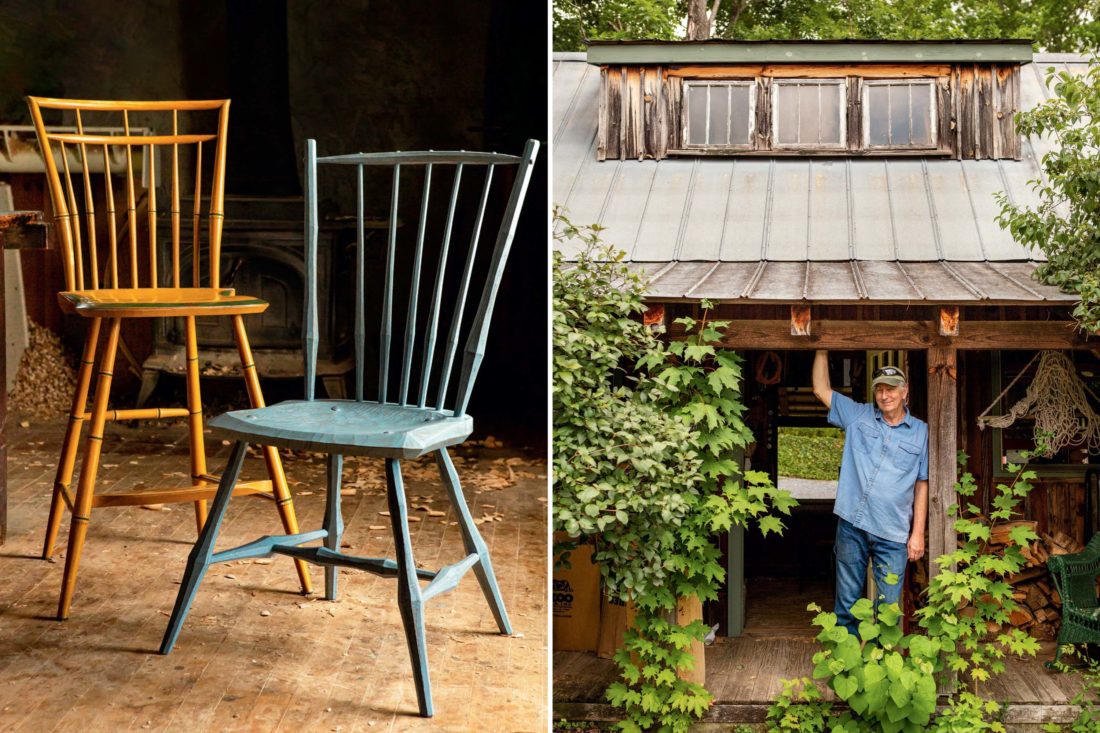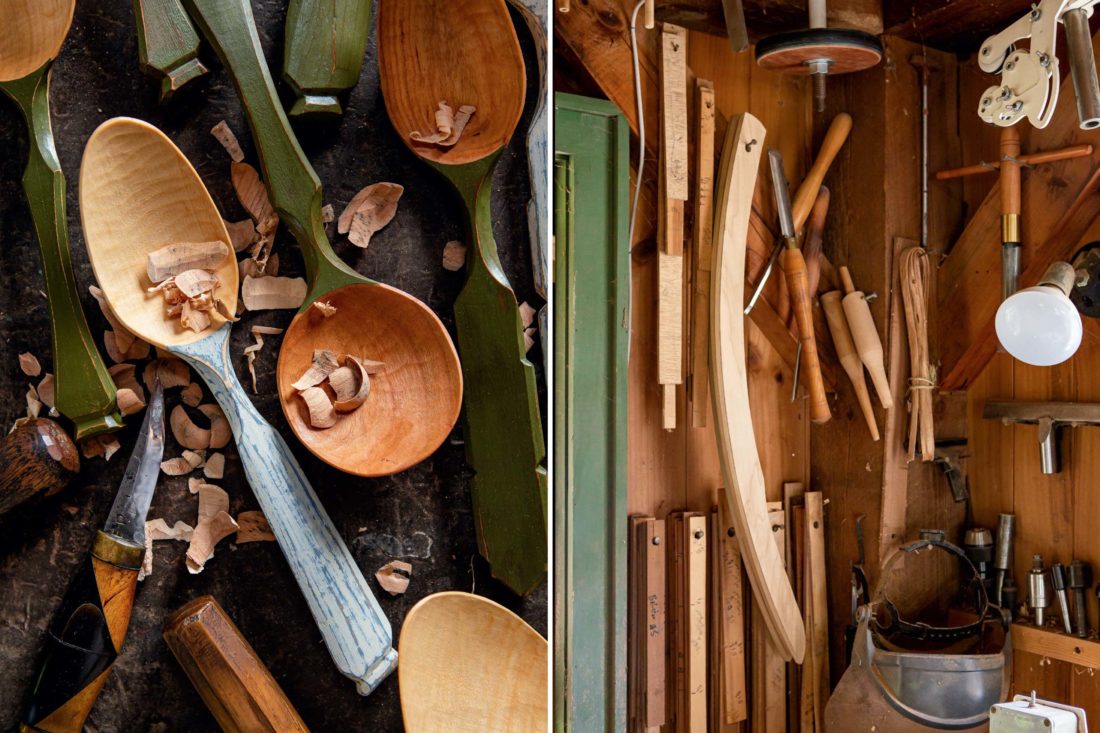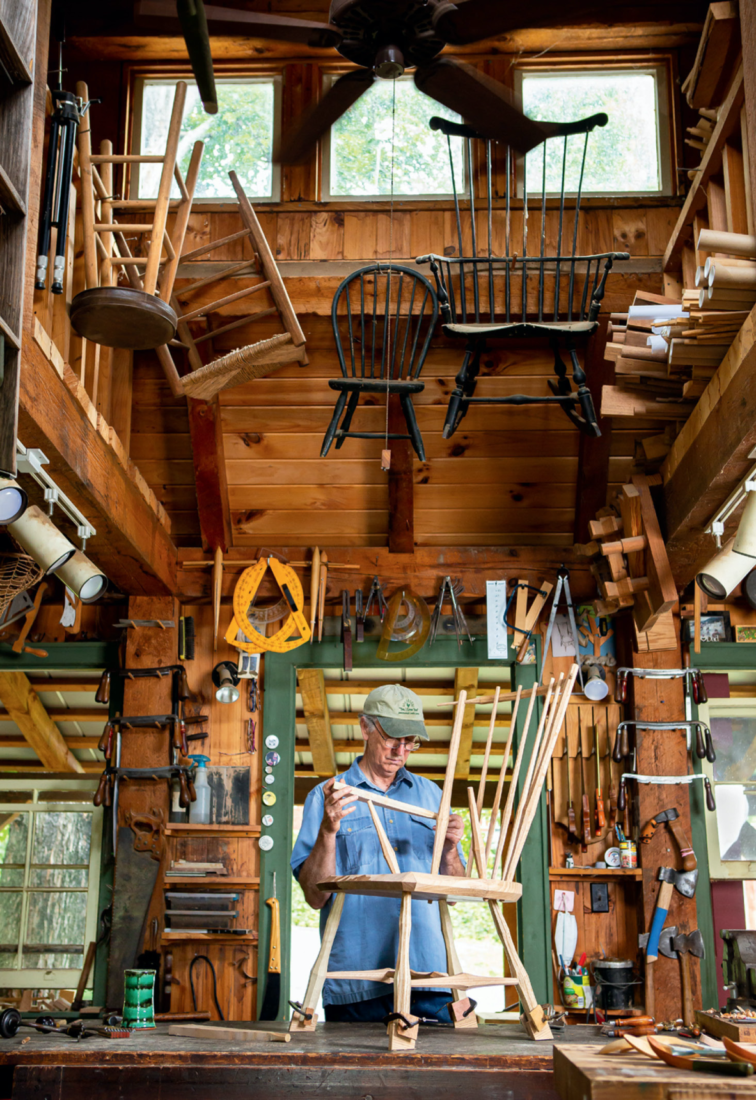On Jonesborough, Tennessee’s East Main Street, past the courthouse, the antique mart, and the historic little town’s single coffee shop, if you listen closely, you can hear Curtis Buchanan splitting a maple log outside his backyard workshop. Chances are, pieces of that log will become one of the elegant handmade Windsor chairs he turns out there. His creations are displayed in collections at Monticello, the Tennessee State Museum, and the governor’s mansion, and visitors to his shop come from all over—but that’s not why he does it. For Buchanan, it’s all about the tools.
“Early on, I ran across a drawknife and a shaving horse, and that was the end of all other work,” says Buchanan, a handyman by nature who, when he was in his twenties, resisted the thought of a nine-to-five. He stumbled upon chair making, and, under the tutelage of the renowned Vermont woodworker Dave Sawyer, began perfecting his craft. “The tools drew me to it, and it’s still the tools that keep me here.” Aside from a lathe and a band saw, nothing in his workshop plugs in. Nothing is so dangerous that his five-year-old grandson or neighborhood kids can’t visit. Nothing buzzes or whirs too loudly.

“The sound of the motors makes you want to go faster,” Buchanan says. His voice, like much else about the sixty-nine-year-old craftsman, is ebullient and unrushed. “I like the sound of the hand tools. They set a pace.” He ditched his radio in the early nineties. Years ago, when his now son-in-law accidentally cut his workshop’s telephone line while digging for a raspberry trellis in the garden, Buchanan thanked him. “It’s the quiet, but also the other sounds I get to hear because of the quiet: the birds, the starter on the mail truck, the courthouse clock.”
Every morning, Buchanan ambles along the gravel path to his sixteen-by-twenty-foot timber-frame workshop, past overflowing flower beds and prolific vegetable patches, through a wisteria-draped arbor where a mockingbird has been known to nest. Most days, he keeps the doors open to let the sounds and sunlight pour through. In the fall and winter, he runs the woodstove as wind and snow blow outside. His workbench and adjacent tool cabinet sit at the center of the room, with old chairs and stools dangling from above. “If I couldn’t make these chairs with these simple tools, I would make something else,” he says. In fact, every morning, he warms up by whittling a spoon.

But it is the chairs that these humble tools make best, so it’s chairs Buchanan continues to produce. He’s crafted rockers, settees, side chairs, and barstools. Lately, he’s been obsessed with what he calls democratic chairs, a sleeker model that requires just a few hand tools. His bread and butter over the course of his career, though, has been the traditional Windsor chair. A sentiment from the twentieth-century furniture historian Wallace Nutting about the classic design, created in England and refined in colonial America, mirrors Buchanan’s ethos: “A Windsor chair, even to a person who does not know it by name, is perhaps more suggestive of pleasant reflections than any other article of furniture,” Nutting wrote. “No other style of furniture has been so persistent and kept its quiet place while other styles came and went.”
Buchanan’s process relies on green woodworking, which means that rather than starting from dry boards, he works pliable logs sourced from nearby sawmills. “I live in one of the most diverse temperate forests in the world, so I have access to everything I need right here,” he says. Since he paints his chairs, he chooses his wood for its nonaesthetic qualities such as high tensile strength, light weight, and tight grain. A single chair represents a walk through a Southern Appalachian forest: He uses hard sugar maple for the legs; ring-porous hardwood such as oak, hickory, or ash transforms into the back and spindles; malleable eastern white pine forms the seat.

After splitting the logs, Buchanan shaves the chair-back with his drawknife before placing it and the spindles in a steam box (a plywood box shaped like a “snake coffin” attached to a wallpaper steamer) to make them even more compliant. Then, after they’re bent, they go into a homemade kiln powered by 100-watt light bulbs. Once they’re dry, he shapes them again with a spokeshave, then starts on the legs, which he turns on his lathe and dries. For the seat, he starts with a single board, flattening it with a hand plane and scooping into it with his adze, scorp, and travisher, sharp carving tools with names much more intimidating than the objects themselves. He fastens each piece by drilling holes with a brace and auger bit, leveraging the moisture in the wood so that some parts expand while holes shrink, cementing the pieces into place. A few coats of milk paint, a rubdown with steel wool, and a top layer of shellac finish the job.

For years, Buchanan had a two-year backlog of orders and cranked out at least a chair a week. He appreciated the business, but he’s glad those times are over. Nowadays, he’s ceased commissions and only sells the chairs he happens to be making, along with the carefully devised plans for how to build each type of chair, plus the spoons he sculpts each morning.
His goal, though, remains unchanged. He recalls a moment, years ago, when he had to decide on what path his career would take. “I asked myself: What did you want in 1983 when you were obsessed with these chairs? I wanted a little shop in the backyard where I could make enough for the family. Then I asked: Is that what you still want?” he says. “The answer is still yes.”








